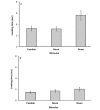Sensitivity to first- and second-order drifting gratings in 3-month-old infants
- PMID: 23145237
- PMCID: PMC3485786
- DOI: 10.1068/i0406
Sensitivity to first- and second-order drifting gratings in 3-month-old infants
Abstract
In two experiments, we investigated 3-month-old infants' sensitivity to first- and second-order drifting gratings. In Experiment 1 we used forced-choice preferential looking with drifting versus stationary gratings to estimate depth modulation thresholds for 3-month-old infants and a similar task for a comparison group of adults. Thresholds for infants were more adult-like for second-order than first-order gratings. In Experiment 2, 3-month-olds dishabituated to a change in first-order orientation, but not to a change in direction of first- or second-order motion. Hence, results from Experiment 1 were likely driven by the perception of flicker rather than motion. Thus, infants' sensitivity to uniform motion is slow to develop and appears to be driven initially by flicker-sensitive mechanisms. The underlying mechanisms have more mature tuning for second-order than for first-order information.
Keywords: Development; first-order; flicker; infants; motion; second-order.
Figures



Similar articles
-
The effect of contrast on vertical motion processing asymmetries in 11-week-old infants.Perception. 2001;30(2):159-66. doi: 10.1068/p3098. Perception. 2001. PMID: 11296497
-
Spatial frequency tuned covariance channels for red-green and luminance-modulated gratings: psychophysical data from human infants.Vision Res. 2000;40(4):431-44. doi: 10.1016/s0042-6989(99)00188-1. Vision Res. 2000. PMID: 10820623
-
Visual motion processing in one-month-old infants: preferential looking experiments.Vision Res. 1996 Jun;36(11):1671-7. doi: 10.1016/0042-6989(95)00236-7. Vision Res. 1996. PMID: 8759467
-
The development of motion sensitivity during the first year of life.Vision Res. 1994 Sep;34(18):2387-402. doi: 10.1016/0042-6989(94)90283-6. Vision Res. 1994. PMID: 7975278
-
The developmental origins of naïve psychology in infancy.Adv Child Dev Behav. 2009;37:55-104. doi: 10.1016/s0065-2407(09)03702-1. Adv Child Dev Behav. 2009. PMID: 19673160 Review.
Cited by
-
Optimizing the rapid measurement of detection thresholds in infants.J Vis. 2015 Aug 1;15(11):2. doi: 10.1167/15.11.2. J Vis. 2015. PMID: 26237298 Free PMC article.
-
Development of BOLD Response to Motion in Human Infants.J Neurosci. 2023 May 24;43(21):3825-3837. doi: 10.1523/JNEUROSCI.0837-22.2023. Epub 2023 Apr 10. J Neurosci. 2023. PMID: 37037605 Free PMC article.
-
The contribution of LM to the neuroscience of movement vision.Front Integr Neurosci. 2015 Feb 17;9:6. doi: 10.3389/fnint.2015.00006. eCollection 2015. Front Integr Neurosci. 2015. PMID: 25741251 Free PMC article. Review.
References
-
- Allen H A, Ledgeway T, Hess R F. “Poor encoding of position by contrast-defined motion”. Vision Research. 2004;44:17–17. - PubMed
-
- Aslin R N, Shea S L. “Velocity thresholds in human infants: Implications for the perception of motion Developmental Psychology”. 2. 1990;6:589–598.
-
- Atkinson J, Braddick O. “Development of optokinetic nystagmus in infants: An indicator of cortical binocularity?”. In: Fisher D F, A Monty R, W Senders J, editors. Eye movements: Cognition and Visual Perception. Hillsdale, NJ: Lawrence Erlbaum; 1981. pp. 53–64.
LinkOut - more resources
Full Text Sources

